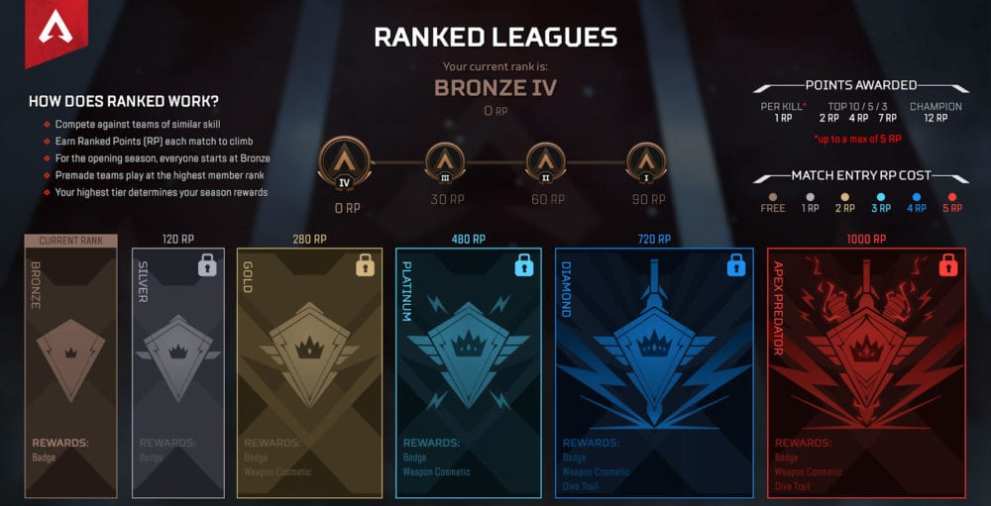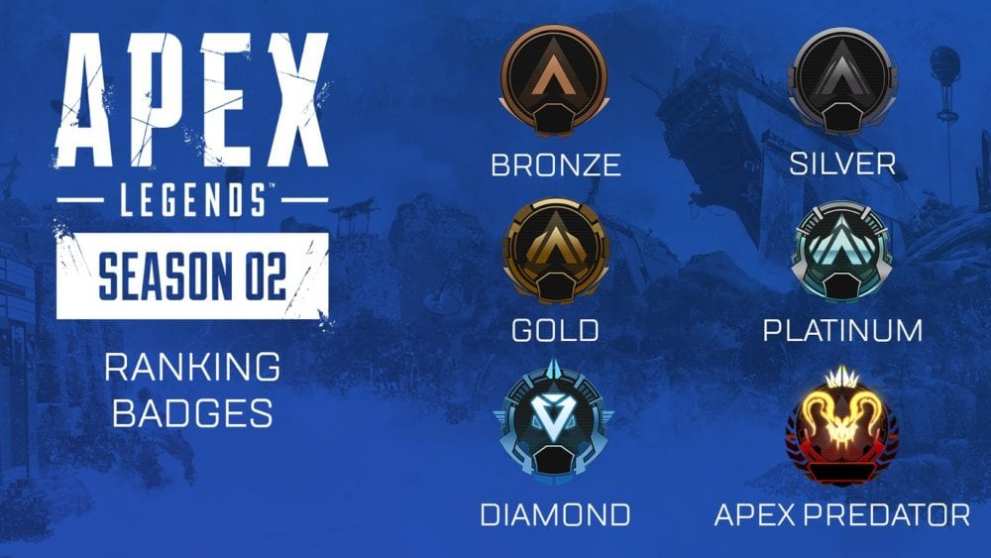Season 2 of Apex Legends has officially begun and that means that, alongside a new battle pass and other new things, the Apex Legends Ranked Leagues have arrived. What are these leagues though? What rewards can you earn? Do the leagues reset? We’ve got these questions and more answered in this guide for you. Here’s Apex Legends Ranked Leagues explained, including ranks, resets, rewards & more.
Apex Legends Ranked Leagues Explained
While you’re free to play Apex Legends however you want, doing so in the new Ranked Leagues is not recommended. That’s because these leagues are for players who are looking to play strategically and competitively.
According to the blog post posted by EA today, the goals for these Ranked Leagues are to reward competitive players for the time they invest in Apex Legends, ensure competitive integrity through skill-based matchmaking, create a space at the top of the ladder for the best players to establish a high-skill meta without forcing a playstyle and create a true measure of skill in the game.
If you want a more detailed breakdown of each of those goals, you can check that out in the blog post.
How the Ranked Leagues Work
According to Respawn and EA via their leagues blog post, Respawn has been running simulations on the scoring system using actual player data from Season 1 to calibrate the way these leagues will work.
Ranks Explained
Ranked Leagues feature six tiers: Bronze, Silver, Gold, Platinum, Diamond, and Apex Predator, with Bronze being the lowest tier and Apex Predator being the highest tier.
Every tier, except for Apex Predator, has four divisions. For example, the Gold tier has Gold IV, Gold III, Gold II and Gold I within it, with Gold I being the highest division within the Gold tier.
At the start of the Season 2 Ranked Leagues, every player will start in Bronze IV. In future Ranked Leagues series, players will be automatically placed into a starting tier based on their performance in past series.

Resets Explained
Per EA, Ranked Leagues will run in periods that they’ve dubbed Series. The first Series is set to run for the duration of Season 2 of Apex Legends (July through September). EA says that future Series may not be synced to the duration of the game’s seasons.
So, in short, Ranked Leagues soft reset at the end of each Series. The end dates will be announced with the start dates before each Series begins.
Rewards Explained
At the end of this first series of Ranked Leagues, players will receive a Series 1 badge based on the rank they finished the Series in. As of right now, that’s the only reward players will receive (alongside notoriety).

Scoring Explained
Ranked Points will determine how much you move up and down the ladder in the Ranked Leagues. You receive RP based on your performance in each match.
Kills are worth one RP with a maximum of five per match. Placing in the Top 10 nets you two RP, Top 5 nets you four RP, Top 3 nets you seven RP and a win will net you 12 RP. These scores are independent, so if you place in the Top 5, you won’t earn RP for Top 10 as well — just Top 5 RP.
With this in mind, the maximum RP you can earn in a match is 17.
Each Ranked match will cost RP to play based on your tier. A Bronze match is free, Silver matches cost one RP, Gold matches cost two RP, Platinum matches cost three RP, Diamond matches cost four RP and Apex Predator matches cost five RP.
Playing With Friends in Ranked Leagues Explained
Ranked Leagues require you to be at least level 10, which means any friend that you want to play with must be level 10 or higher. To play with friends, queue up in the lobby with the friends you want to play with and the matchmaker will find a match based on the highest ranked player in the lobby, but each player must pay the appropriate match cost for their current rank.
It’s important to note that if a Gold player is playing with their Bronze friend, both players will be competing in a Gold tier-level match.
Ladder Movement Explained
As mentioned above, everyone will begin Series 1 of the Ranked Leagues at Bronze. Currently, there is not demotion so if you get to Silver, you will never drop back into Bronze.
Despite that, though, demotion is possible within each tier. For example, you can drop from Gold 1 within the Gold tier to Gold IV, but you’ll never drop from Gold to Silver. According to the blog post, demotion in tiers might come in a future series.
Penalties Explained
Players who abandon a match midway through it will be hit with a matchmaking penalty for not only Ranked matches, but regular matches as well. These penalties will result in the penalized players being unable to join a match for specified amounts of time, amounts of time that increase with each penalty.
Respawn considers an abandoned match as any match you leave before its over for you — leaving during character select, leaving while you are alive, and leaving while dead but still able to be respawned by teammates is considered an abandoned match.
The first penalty will come with a five-minute bar from joining matches and the highest you can be barred from joining a match is one week.
Loss Forgiveness Explained
Ranked Leagues will have a loss forgiveness system and it’s similar to the Elite queue loss forgiveness system. Respawn defines loss forgiveness as zeroing out any potential loss of RP in a match.
Players will be granted loss forgiveness when their matchmade teammates abandon the game and for situations where a player is forced out of a match for a reason they can’t be blamed for such as client errors.
That’s it for our guide on Apex Legends Ranked Leagues explained, including how ranks, resets, reward and more work in Series 1.
For more information about Apex Legends Ranked Leagues or anything else about Apex Legends Season 2, be sure to check out our Apex Legends Season 2 Guide Wiki. There, you’ll find tips, tricks, walkthroughs and more to help you secure the win.
